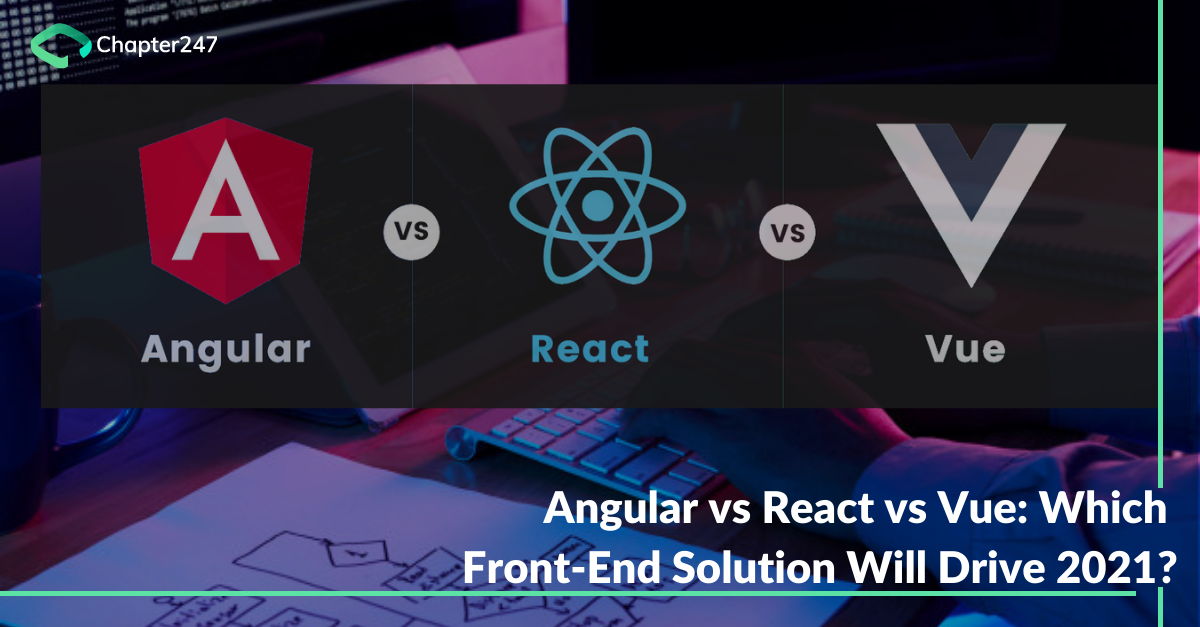The past decade has seen the evolution of front-end frameworks like never before. There’s also a good number of front-end solutions and libraries available for developers to choose from based on the needs and scope of development projects. However, one challenge that automatically comes with the availability of options is the decision about arriving at the right one. Today, CTOs must decide between Angular, React, or Vue – three of the best front-end development options being used by companies around the world. A React developer may wonder today if Vue would become a future option or if Angular would continue to rule the front-end development projects.
Before we dig in, let us first understand what each of these solutions is.
Angular – a JavaScript open-source framework
React – is a library, when used in conjunction with other tools, becomes a framework
Vue – a library, when used in conjunction with other tools, becomes a framework
So what are we comparing exactly?
We are actually comparing which one of these solutions is best for front-end development considering the ever-changing needs of web and mobile application development. While Angular, as a complete framework, offers an array of features for the developers, React and Vue – being libraries, have faster learning curves and quicker performance – a factor that trumps the fact that they need other tools for complete front-end development.
This blog aims at evaluating each of these based on scope, performance and benefits.
Angular
Angular framework belongs to the MEAN stack – the most sought-after technology stack for startups. Angular is a complete framework for web application development based on TypeScript and is primarily used for building single-page web applications (SPAs).
Scope
Angular is a front-end open-source framework on JavaScript. It is best suitable for large-scale and advanced projects. You can use Angular if the scope of your project entails one or more of the following:
- Upgrading website application design
- Building dynamic content-based designs
- Creating large enterprise application that needs complex infrastructure
- Developing Progressive Web App (PWA)
- Updating/improving the UI of large websites through re-design
Performance
Some highlights in Angular’s performance are:
1] Angular offers seamless third-party integrations for enhancing the functionality of the product/application.
2] It provides a robust collection of components leading to simplified art of writing, altering, and using the code.
3] Angular’s ‘ahead-of-time-compiler’ bestows faster load times and security strength.
4] The MVC model helps in curtailing queries in the background by allowing separation of views.
5] With Angular, you can use dependency injection as external elements for decoupling components that make way for reusability and ease of management and testing.
6] Due to the MVC structure, Angular can reduce the initial load time of a webpage by splitting the tasks into logical chunks.
7] Angular equips designers and developers with fully customizable designs.
8] Angular facilitates the compiling of HTML and TypeScript into JavaScript – a feature that results in the faster compilation of the code much before the browser starts to load the web app.
Benefits
Angular’s built-in functionalities make the life of developers easier. It is a widely used framework and is constantly updated, so you may pose the most challenging and weirdest cases and the Angular community will have answers. Let us now examine some of its biggest benefits:
1] Well-documented understanding of templates, forms, bootstrapping or details about architecture, components and interaction between components
2] Easy two-way data binding
3] MVC architecture
4] Significant reduction of the initial load time of a webpage
5] Built-in module system
6] Large and thriving ecosystem
| Popular use cases built with Angular Youtube TV | PayPal | Gmail | Forbes | Google Cloud |
React
Largely used for developer user interfaces, React is an open-source, front-end library. It belongs to the MERN stack – a technology stack that’s popular for building sophisticated business applications. React today has become a preferable library due to its simplicity and its focus on user experience.
Scope
React becomes a powerful tool when used in conjunction with Redux or MobX or any flux patterned library. That means you may not need React in every project. It is best suited in the following situations –
- For projects that involve many components with navigation items, collapsed/expanded accordion sections, active/inactive states, dynamic inputs, active/inactive buttons, user login, user access permissions etc
- For applications that have scope for scale and growth because React components have declarative nature that makes way for easy handling around such complex structures
- When UI is the center of the web application in terms of its scope or use
Performance
In terms of performance, React is comparable to Vue. Both Vue and React have the same architecture i.e interaction with DOM. However, if we had to highlight the performance of React web development, here are some points to consider:
1] Supports bundling and tree-shaking – a feature crucial for reducing the end users’ resource loads.
2] Due to its one-way data binding support, React offers better control over the project.
3] Easily testable and monitored
4] Ideal for complex applications that require frequent changes due to the efficiency bestowed through virtual DOM
Benefits
React JS library is created by Facebook and hence it enjoys a large community of coders and developers offering solutions to the biggest problems or challenges.
- Large community and the ecosystem due to Facebook’s regular updates
- Flexible code owing to its modular structure. Saves time and cost
- Enables high performance of complex apps
- Supports mobile native applications for both Android and iOS platforms
- Code is easier to maintain during React front-end development
| Popular use cases built with React Tesla | AirBnB | CNN | Nike | Udemy | Linked-in |
Vue
Used for developing user interfaces and SPAs, Vue is an open-source Model-View-View-Model front-end JS library that is used with other tools for front-end development. Vue is popular among the development community because of its versatility, high performance, and its optimal user experience on a web application.
Scope
When you want to solve short-term problems with great functionality, the solution has to be quick and running. This is where Vue comes in since it has an affordable and quicker learning curve and it can integrate with existing code blocks easily. However, here are some broad areas of work where Vue may be required:
1] Development projects of web apps that need animations or interactive elements
2] Prototyping without the need for advanced skills
3] Faster launch of MVP
4] Applications requiring seamless integration with multiple other apps
Performance
Incredibly fast is the phrase that’s most attached with Vue. Some of its performance metrics are:
- Faster learning curve
- Efficient and sophisticated single-page application
- High-end features make it versatile
Benefits
Vue in a way has all the right characteristics of React library and Angular framework, as a result, it is easy to learn and get accustomed to. Here are some important benefits that Vue offers:
1] Easy to download and install due to its small size
2] When properly harnessed, Vue is easily reusable
3] Vue.js allows updating of elements in a web page without rendering the whole DOM since it is virtual.
4] Stimulates web application development and allows the experts to separate template-to-virtual DOM from the compiler
5] Requires less optimization
6] Proven compatibility and flexibility as it uses HTML to render objects and has a template system for seamless integration of existing applications
7] The codebase remains light even as the application scales
| Popular uses cases built with Vue Gitlab | Spendesk | Behance | 9Gag | Wizzair | Nintendo |
Must read: React Native vs Flutter – Which one to choose for Cross-Platform App Development
Final thoughts
Just like their performance, scope and benefit, all the three front-end solutions have their own set of cons. However, you must make a choice based on the above factors because these will affect your overall development process. The learning curve is an important factor to be considered apart from performance and benefits. It is imperative to add here that React has an easier learning curve and that’s what makes it more popular.
Another vital factor would be how large is the ecosystem or community for each of these frameworks. That’s because a large thriving community has all the answers you need when you get stuck in project development.
Now the big question: Must you learn Vue, React or Angular in 2021?
From the point of view of development, React will be the quickest to learn in 2021. Then come Vue and Angular. Vue and React both are lightweight, intuitive and perform flawlessly.
If you have any queries, thoughts or opinions on these frameworks, do drop in a line in the comments section. If you are looking to hire reactjs developers, feel free to contact us here. As a ReactJS development company, we have a track record of building stunning web applications using this technology.






